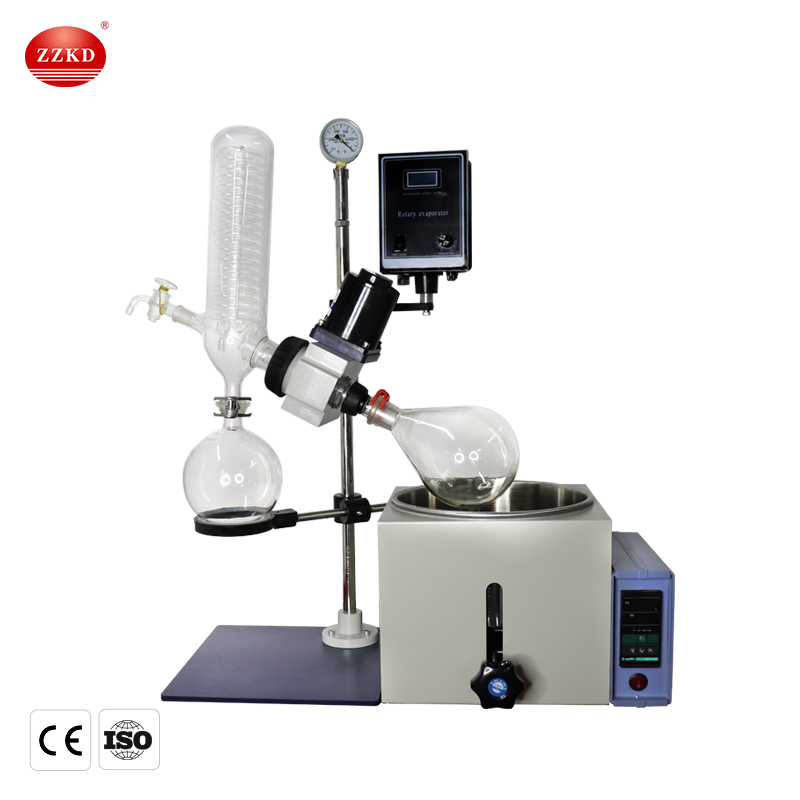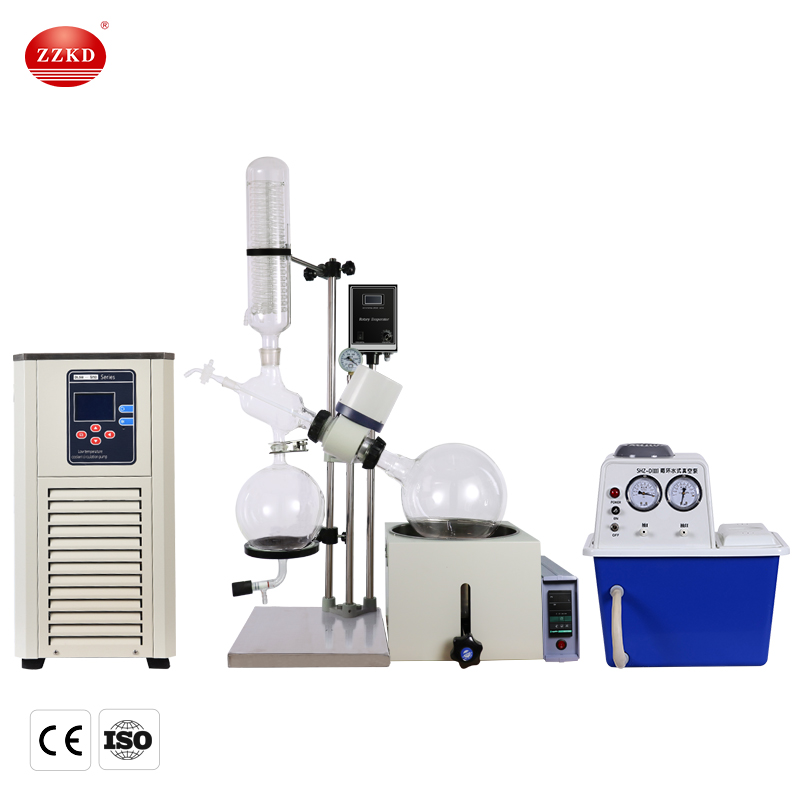Small Capacity Glass Rotary Evaporator Distillation Unit
Our company sells small-capacity rotary evaporator distillation unit in stock for a long time, including 2L rotary evaporator distillation unit (RE-201D and RE-5299), 3L rotary evaporator distillation unit (RE-301), 5L rotary evaporator distillation unit (re 501 rotary evaporator), etc. In addition, our company also has large capacity rotary evaporator distillation unit, such as 10 liter rotovap and so on.

Rotary Evaporator Distillation Unit Description:
1. The glass parts of RE series small capacity rotary evaporation equipment (condenser, rotary bottle, receiving bottle, four-way bottle, glass through shaft and feeding piston with PTFE tube) are made of corrosion-resistant, high-temperature resistant GG-17 high borosilicate glass production;
2. The mechanical parts of RE series small-capacity rotary evaporation equipment are made of stainless steel and aluminum alloy die-casting;
3. The water bath of RE series small-capacity rotary evaporation equipment is manually raised and lowered.
Rotary Evaporator Distillation Unit Working Principle:
In the use of rotary evaporator in laboratory, the reaction mixture is charged into a rotary evaporation flask, which is then lowered into a water/oil bath or electric heating mantle. The reaction mixture is heated while uniformly heating the sample. The flask was rotated at a constant speed at a suitable speed to increase the evaporation area. The evaporating flask is under negative pressure by means of a vacuum pump. The evaporation flask is placed in a water bath for constant temperature heating while rotating, and the solution in the flask is heated, diffused and evaporated in the rotating flask under negative pressure. The rotary evaporator system can be sealed and decompressed to 400-600 mmHg; the solvent in the distillation flask is heated with a heating bath, and the heating temperature can be close to the boiling point of the solvent; at the same time, it can be rotated at a speed of 50-160 rpm, The solvent is formed into a thin film and the evaporation area is increased. In addition, under the action of the high-efficiency cooler, the hot vapor can be quickly liquefied and the evaporation rate can be accelerated.In the serpentine condenser tube, there are two jacketed tubes: a coiled tube in which cold water flows to cool the solvent vapor, and a straight tube connected to a vacuum pump to suck out the vapour. When the reaction mixture is heated and the circulating water vacuum pump is turned on, the pressure inside the vacuum tube is reduced, which in turn facilitates the boiling of the solvent at a lower temperature. Therefore, the solvent vapor can travel up the condenser, encounter the serpentine with cold water, condense and collect in the receiving bottle.
By doing this, low-boiling solvents such as n-pentane can be quickly removed. However, high boiling point solvents (ie dimethyl sulfoxide) can also be evaporated if the circulating water vacuum pump is powerful enough. The end result is a fairly pure reaction product that can be used for further purification and/or chemical analysis.
Rotary Evaporator Distillation Unit Grouped Equipment:
1. Desktop circulating water vacuum pump: It uses circulating water as the working fluid to provide vacuum conditions for the rotary evaporation process.Optional double meter with two taps, four meter with four taps;
2.low temp pump: It adopts the principle of mechanical refrigeration for low temperature cooling, and the lowest temperature can reach -120℃.

Rotary Evaporator Distillation Unit Precautions:
2. Each interface, sealing surface, sealing ring and joint need to be coated with a layer of vacuum grease before installation;
3. The solvent capacity of the rotary evaporation flask cannot exceed 1/2 of the volume of the rotary evaporation flask;
4. Before electrifying the heating tank, the heating solvent must be injected, do not dry it;
5. When the vacuum degree is insufficient, check the air tightness of each interface;
6. Glass parts should be handled with care when installing, and should be cleaned and dried before installation;
7. The rotary evaporator cannot carry out strong alkali reaction;
8. When rotary-evaporating air-sensitive substances, connect a nitrogen balloon to the exhaust port, first pass a burst of nitrogen to discharge the air in the rotary evaporator, and then connect the sample bottle for rotary evaporation. After evaporating, release nitrogen to increase the pressure, then turn off the pump, then remove the sample bottle and seal it;
9. If the viscosity of the sample is very large, the rotation speed should be slowed down and rotated slowly by hand, so that a new liquid level can be formed and the solvent can be evaporated.
Rotary Evaporator Distillation Unit Maintenance:
1. Carefully check the rotary evaporation equipment before use, whether the glass bottle is damaged, whether the interfaces are consistent, and pay attention to handle it with care;2. Wipe each interface with a soft cloth (can be replaced with a napkin), and then apply a little vacuum grease. Be sure to cover the vacuum grease after use to prevent lime and sand from entering;
3. Each interface should not be tightened too tightly, and the loose joints should be loosened regularly to avoid long-term locking that would cause the connector to die;
4. Turn on the power switch first, then let the machine run from slow to fast. When the machine is stopped, keep the machine in a stopped state, and then turn off the switch.
5. The PTFE switches everywhere should not be over-tightened, which will easily damage the glass.
6. After each use, all kinds of oil stains, stains and solvent residues left on the surface of the machine must be wiped with a soft cloth to keep it clean;
7. Loosen each PTFE switch after stopping, and the PTFE piston will be deformed if it is still in the working state for a long time;
8. Clean the sealing ring regularly: remove the sealing ring, check whether there is dirt on the shaft, wipe it with a soft cloth, then apply a little vacuum grease, and reinstall it to keep the shaft and the sealing ring smooth.
If you want to get the price of rotary evaporator, please contact us in time!
We will give you the quotation you want in time!
ZZKD will serve you wholeheartedly!




